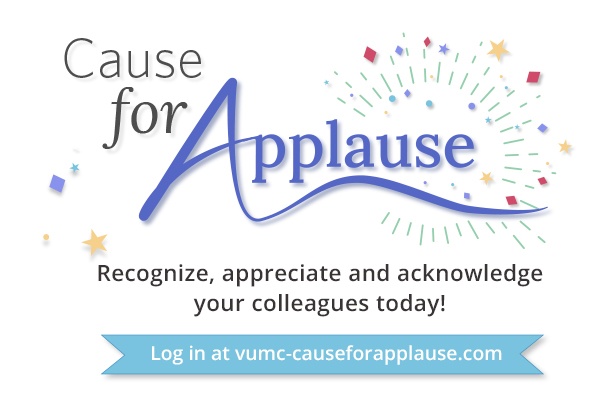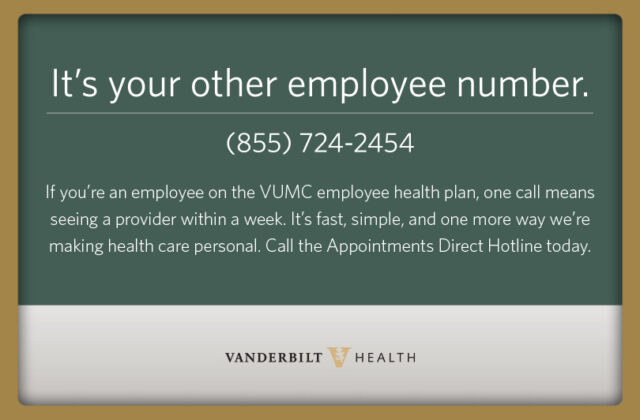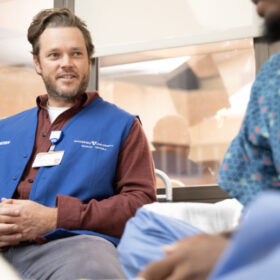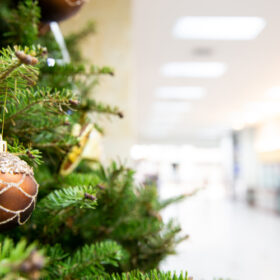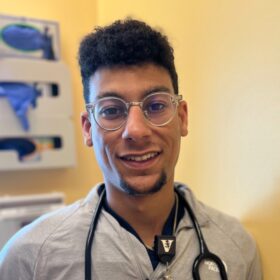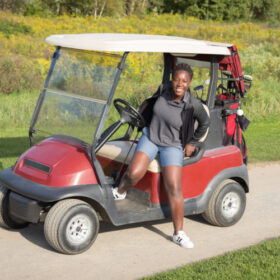I went for a walk at lunchtime and was hit by a car. Here’s what I want drivers and pedestrians to know to protect others.
I became vaguely aware of the sound of sirens in the distance. I soon realized the sirens were coming for me.
April 2, 2018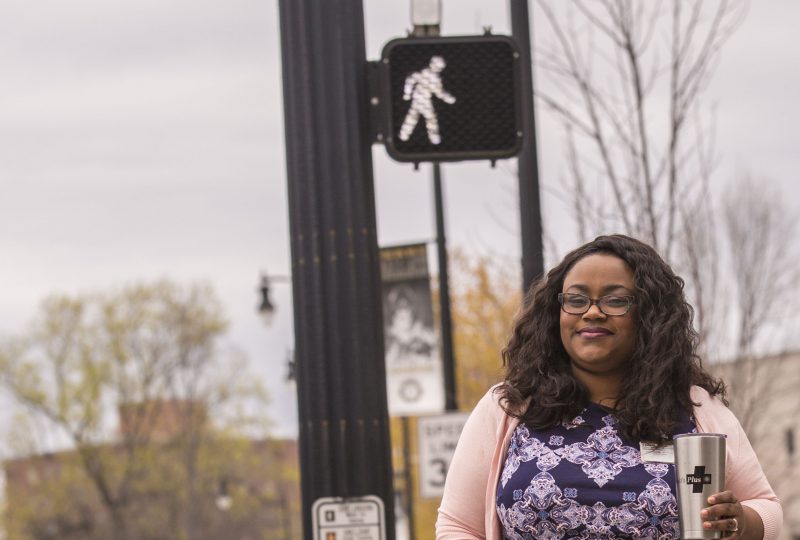
Tavia Smith is a writer in the VUMC News and Communications office. Photo by Anne Rayner
It was a bright, sunny fall day — Sept. 13, 2011.
I was working in downtown Clarksville then, it was around midday, and I was waiting at a crosswalk for the “Don’t Walk” sign to turn to “Walk.” It did. I looked left, looked right and stepped into the crosswalk.
I heard tires squeal from behind me. I saw a flash of red dart into my far peripheral vision for a split second.
And then I felt a heavy force hit my body.
A driver in a Dodge Charger, a car that, I later learned, weighs more than 5,000 lbs., had made a left turn at a green light into the crosswalk where I was walking. The driver later said he did not see me, and since he had come from behind me and not from the left or right, I didn’t see him either.
I looked up, confused and numb. People were running to me, surrounding me, touching me. They asked me questions. I stared at them all in confusion.
At that moment of impact, everything seemed to happen in slow motion. A woman screamed, the sound of the car hitting my body seemed to echo off nearby buildings. I screamed, too, but — this is weird— I couldn’t hear myself.
I went flying through the air and had a brief glimpse of the white clouds in a mostly blue sky, before slamming onto the gray pavement.
The papers and my cell phone I was carrying exploded into cascading confetti. My shoes followed.
I looked up, confused and numb. People were running to me, surrounding me, touching me. They asked me questions. I stared at them all in confusion.
“What happened?” I thought to myself, quickly searching the unfamiliar faces.
I couldn’t speak. I was in shock. But then the question came to me: “Had I been hit by a car?”
I had. I’d landed hard, ripping the tendons in my left foot and damaging muscles all over my body.
I became vaguely aware of the sound of sirens in the distance. I soon realized the sirens were coming for me.
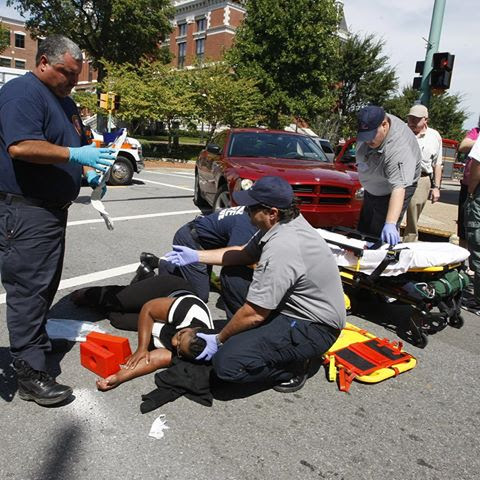
First responders comfort Tavia Smith shortly after she was hit by a car. (Photo courtesy Tavia Smith)
Suddenly, tears began pouring from my eyes. I noticed how much my feet hurt. The people gathered around me kept telling me not to move. The growing crowd watched as police cordoned off the intersection with crime scene tape.
Soon the paramedics were equipping me with a neck brace and strapping me to a board to whisk me to an emergency room.
My husband heard about what had happened and rushed to the scene. He had heard I’d been in a car accident, and was confused because our car wasn’t there, and I had already been taken away in an ambulance. A co-worker saw him there and handed him a brown bag filled with my shoes and other belongings, and he rushed to the emergency room to be by my side.
Getting hit by a car is a bad thing — believe me, I know — but I am one of the blessed ones. I didn’t break any bones or have traumatic internal or external injuries. I was hurt, and my recovery took a long time, but I survived and lived to tell the story.
That was seven years ago, and in the time since, thousands of other pedestrians have been hit by cars, and many don’t live to tell what happened.
Last year in the U.S., almost 6,000 pedestrians lost their lives after being hit by vehicles.
In 2017, 22 pedestrians in Nashville lost their lives in this manner.
And you know what’s the worst part? These are preventable deaths.
I was 25 years old. I had a job I loved as a newspaper reporter and had only been married 11 months when I was injured. I spent the next year on a cane and in therapy, just learning to walk correctly.
Auto-pedestrian accidents are largely attributed to distracted drivers and pedestrians who are not alert to their surroundings and while it only takes a second to make a bad decision, the resulting injuries can be debilitating and life altering.
“Auto-pedestrian injuries typically result from pedestrians stepping into the street without realizing a vehicle is traveling toward them,” said Oscar Guillamondegui, MD, associate professor of Surgery and medical director of the Trauma Intensive Care Unit at Vanderbilt University Medical Center.
“The pedestrian may be distracted by inebriation from drugs or alcohol, talking on the phone, texting, or walking with earbuds and not being aware of their surroundings.”
Bicyclists, pedestrians walking at night, and children are the three most common types of auto-pedestrian patients treated at Vanderbilt’s emergency department.
Many pedestrians who are hit by a vehicle face traumatic pelvic, femur and wrist fractures as well as damage to internal organs.
“When a person is typically hit by a car it is from the side as they step off a curb,” Guillamondegui said. “The mechanism starts with the car identifying the pedestrian and slamming on the brakes, which drives the bumper down. This effectively makes the initial contact point the lower leg in adults and the upper leg, or femur, in children.”
The injuries from being struck by a car are so distinctive that they have a name, the Waddell’s triad: leg fracture, internal organ injury and head injury.
Pedestrians may face further internal injuries as they are thrown onto the hood of the car, or their head strikes the vehicle or ground.
The injuries from being struck by a car are so distinctive that they have a name, the Waddell’s triad: leg fracture, internal organ injury and head injury.
A few precautionary measures could prevent critical injuries and even death.
“The most important tip for both drivers and pedestrians is vigilance,” Guillamondegui said. “Be ever aware of where one is driving and playing. If driving through a neighborhood, respect the speed limits and keep an eye out for children playing in the area. For pedestrians, always look both ways before crossing the street. For cyclists and joggers, utilize protective high-visibility clothing and flashing lights to make your presence known to traffic and, remain vigilant in high-traffic areas.”
I agree 100 percent. Please pay attention.
I was 25 years old. I had a job I loved as a newspaper reporter and had only been married 11 months when I was injured.
I spent the next year on a cane and in therapy, just learning to walk correctly.
While my injuries were minor to the eye, I still deal with the aftermath. I have fibromyalgia, problems walking, chronic back pain, post-traumatic stress, and anxiety issues.
Every few years, I have to go back to physical therapy for ongoing issues with my body. I had my first child last year, and my pregnancy was painful and difficult due to ongoing issues from the auto-pedestrian wreck.
I have been told, and I know it’s true, that my body will never be the same as it was when I walked out on that sunny day seven years ago.
But again, I know things could have been much worse, and I’m very blessed. But I share this experience to say:
Drivers: It takes a second to stop and think, watch the crosswalks, streets and parking lots for pedestrians. It takes a good decision to get off your phones or even just take a second look to avoid these types of wrecks.
Pedestrians: It takes a second to listen, look for oncoming traffic and take a second look, pause at the crosswalk before running or jogging across, be aware of the driver even if they aren’t aware of you.
Parents: Talk to your children about how to stop, look and listen before crossing a street.
As the days get longer and we yearn to walk, jog and enjoy the outdoors, let’s promise to be more vigilant.
It could truly be the difference between life and death.
Vanderbilt University Medical Center recommends the following tips* to keep pedestrians and bicyclists safe
Pedestrians
- Obey all traffic signals. Pedestrians, cyclists and motorists are responsible for obeying laws and keeping themselves safe.
- Cross the street at a designated crosswalk, or an intersection with a traffic or stop sign. Utilize sidewalks.
- Always look both ways before crossing the street, even when at a light or crosswalk. Look again before proceeding into the roadway.
- Always walk against traffic if no sidewalk is available, and you must walk on the side of the road.
- Avoid using your phone or texting while crossing intersections: Be aware of your surroundings. If you are listening to a music device, make sure you can still hear cars and emergency vehicles.
- If you are getting off the bus, always cross in front of the bus so the driver can see you.
Drivers
- Drive distraction free. Texting, checking email and talking on the phone are just some of the ways drivers can be distracted, and crashes or deaths can occur.
- Respect all bicyclists as legal road users with the same rights and responsibilities as motorists. Maintain at least three feet between your vehicle and the bicycle in front or beside you. By law, you cannot pass a cyclist unless you have three feet of space between you and the cyclist. Wait until there is a safe opportunity to pass.
- Pedestrians have the right of way at all marked and unmarked intersections.
- Stop your vehicle before the crosswalk markings.
- Decrease your speed. Speeding greatly increases your chance of a crash with a cyclist or pedestrian; and just a 5 mile-per-hour decrease in speed can be the difference between a crash or death.
- Look for pedestrians and cyclists when opening your car door. It is the driver’s responsibility should any collision occur.
- Take special precaution when near pedestrians with a cane or guide dog.
- Slow down in residential neighborhoods, particularly during twilight hours between 5:30 to 9:30 p.m.
- Be especially alert and take extra time to look for children at intersections, on medians and on curbs.
- Reduce any distractions inside your car, such as talking on the phone or eating, so you can concentrate on the road and your surroundings.
*Safety information courtesy of Nashville.gov, NashVitality program.




